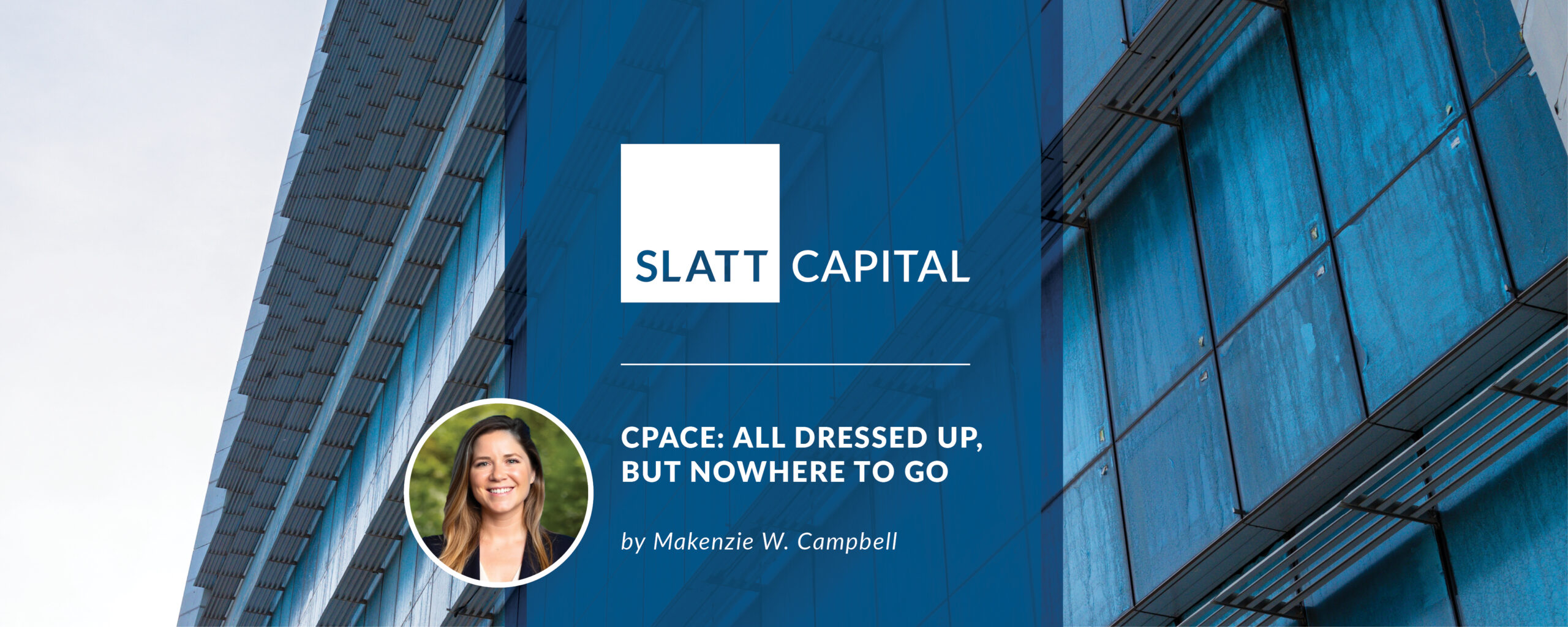
CPACE: All Dressed Up, but Nowhere to Go
It seems CPACE is all the rage today. In the capital markets, everyone and their dogs are opening a CPACE originations shop. Why? Because values today are penciling lower than they were four years ago. Lenders are coming up short on proceeds due to the drop in values, so there’s a need to fill the gap in the capital stack.
Instead of sourcing more equity at high-teen returns, CPACE offers a smarter solution—an affordable financing product for energy-efficient buildings. Created and approved at the state level, it’s currently available in over 30 states and expanding rapidly. Plus, let’s be real—labeling something as “sustainable” and “energy efficient” makes us look like good citizens of humanity. So… why not?
What Is CPACE, Anyway?
TL;DR – CPACE stands for Commercial Property Assessed Clean Energy. Yeah, it’s a mouthful, but stick with me—it’s way cooler than it sounds.
It’s a financing tool that allows property owners to fund energy-efficient upgrades, building envelope materials, MEP systems, structural reinforcements, or even seismic retrofits. Depending on local legislation, it can cover 25–35% of a project’s completed value.
Current rates? 7–8.5%—a steal compared to mezz debt or preferred equity.
How CPACE Works
CPACE isn’t a loan—it’s an assessment tied to your property taxes. Payments are fixed over 10–30 years, with minimal prepayment penalties. The funds are available at closing, held in escrow, and the repayment shows up as a line item on your tax bill.
The best part? If you sell the property, the assessment transfers with the sale. This makes CPACE flexible, sustainable, and often a net positive on operating income through lower utility bills. In some cases, the cost can even be passed through to tenants via NNN leases.
What’s the Catch?
Senior lenders don’t like it. Optically, it is “senior” to their position – at least that’s what they’re sticking with. We can source CPACE quotes all day, you will feel like the belle of the ball. But good luck finding a senior lender who will consent.
But Seriously—It’s Not That Scary
Think of CPACE like a bid tax: the property owner “bids” into the program by agreeing to the assessment for specific improvements, such as energy-efficient upgrades. This annual payment takes priority over other liens, similar to regular property taxes, but the remaining unpaid balance of the assessment stays subordinate to the senior lender. It’s an obligation to make future payments. There’s no deed in trust, so the CPACE lender can’t impede.
Yes, it has cash flow priority, but CPACE is passive capital. If payment is made the CPACE lender has no rights to accelerate. If missed, they only have the right to accelerate the then due annual payment.
So What’s the Solution?
The solution in our eyes is purely education for more senior lenders, and of course, some sort of reserve structure for the annual tax payment. It doesn’t work for every deal, but when it does pencil, it’s an excellent gap capital solution. For example, our firm recently sourced a CPACE loan at completion of construction to replace the high-interest rate preferred equity tranche within the capital stack behind the bank loan. This worked out as the best option as it provided the necessary proceeds to retire the entire high-interest rate preferred equity, but also the flexibility and lower rate that comes with a senior bank loan.
CPACE in Action
Recent transactions showcase just how versatile and effective CPACE can be. In St. Louis, a $35 million CPACE loan was used to finance Gateway Studios, a new state-of-the-art production facility. This funding substituted more expensive construction capital and is projected to save nearly $49 million in energy costs over the life of the loan. Meanwhile, in Houston, a 267-key luxury hotel near the Texas Medical Center utilized CPACE to refinance maturing debt, retroactively covering sustainable improvements like HVAC systems and water-efficient fixtures—showing how CPACE can right-size the capital stack in a tight lending environment .
CPACE is Here to Stay (For Good)
As we continue to learn about the viability of CPACE – it’s clear that it’s not going anywhere. Personally, I see CPACE as a product that institutional banks should be offering because they finance construction projects, they can maintain a lower risk position (sub 60% LTC), they require deposits (CPACE is funded into an escrow account day one), and they have the infrastructure for selling it in secondary markets, like bond securities.
So yes, CPACE may still be standing awkwardly on the sidelines today… But give it time—this wallflower won’t stay unnoticed forever.